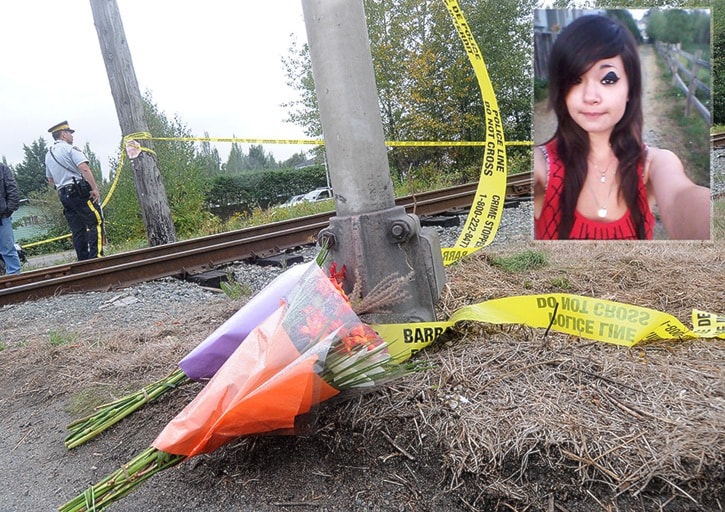B.C. Attorney General Suzanne Anton says she is in discussions with federal Justice Minister Peter McKay on potential ways to tighten monitoring of released high-risk criminals in the wake of the murder of Surrey teen Serena Vermeersch.
Expanded use of electronic monitoring "is something that probably should be considered," Anton told reporters last week after the arrest of convicted rapist Raymond Lee Caissie.
Now charged with second-degree murder, the 43-year-old Caissie was released from prison into Surrey last year after serving a 22-year sentence for a violent sexual assault and robbery in Abbotsford in 1991.
The Parole Board repeatedly refused to grant him early release, citing a high risk to reoffend and seriously harm or kill someone.
"He was identified publicly as being a violent sexual offender," Anton said, noting Caissie has been under police surveillance since his release.
"Everybody who was involved took this case and this person very seriously. Whether or not there are more things that could be put in place – that's a question I've raised with the federal minister."
Asked if the province adequately funds its Integrated Sexual Predator Observation Team, Anton responded: "They are resourced. They don't watch the person 100 per cent of the time. Could they watch them more? Again, I think that is a question that can be considered in this case."
Anton called it a terrible tragedy.
"We expect that our daughters should be able to be safe when they're waiting for a bus," she said. "Serena Vermeersch was not safe that day. We owe it to her and to her family to do what we can to put into place things that keep our community safe."
Premier Christy Clark on Friday said the province wants "a tougher set of rules for high-risk offenders who are a real danger in our communities."
She said expanded electronic monitoring may offer "a second line of defence" but the focus must be on keeping high-risk offenders out of communities in the first place.
Clark said she also awaits recommendations from Abbotsford-South MLA and former University of the Fraser Valley criminologist Darryl Plecas, who is leading a blue ribbon committee on crime reduction.
SFU criminologist Rob Gordon predicted it would be "hellishly hard" to try to declare a soon-to-be released convict a dangerous offender to keep them in prison beyond the full sentence when such a determination was not sought at sentencing.
"I don't think it's feasible," he said, suggesting the focus should instead be on the already available use of tight, well-enforced conditions of release imposed by the court.
Sex offenders are often subject to overnight curfews and a ban on visiting places such as swimming pools, schools or using the Internet.
But Gordon said conditions for release can be so restrictive that a high-risk offender is essentially subject to house arrest, electronically monitored by ankle bracelet and allowed just an hour or two a day away from home, with intense police surveillance at those times.
Such court orders are usually for one or two years but can be renewed with a judge's approval.
Whether the community is kept safe depends heavily on how well the order is enforced, Gordon said, adding that depends on police resources.
Officers can't monitor all offenders all the time, he noted, so they tend to closely watch high-risk offenders soon after release and then – if the subject is doing well – move on to others.
"Stronger laws are not the answer," Gordon said. "We need better and more intelligent surveillance of these people."
Crown did not seek electronic monitoring of Caissie and Gordon said the release conditions placed on him were relatively weak.
"There's a whole bunch of things that could have been in the court order governing this fellow but weren't," Gordon said. "Somebody dropped the ball here."
B.C.'s use of electronic monitoring has declined in recent years.
He also questioned why offenders like Caissie who serve their full statutory sentence do not get the same assistance in entering programs and finding work and accommodation as parolees who are released sooner.
Gordon said there were signs that Caissie was "totally institutionalized with no clue how to survive on the outside" and might seek out trouble to get back inside.
Earlier this year, Caissie was sentenced on two more charges, receiving a three-month term for failing to report to his parole officer, and a 21-day jail term for shoplifting at a Surrey Winners store.
PICTURED ABOVE: Raymond Lee Caissie
OFFENDER MONITORING IN B.C.
- 31 offenders released in B.C. who have completed their sentences are currently subject to court-imposed terms and conditions because they have a high risk to reoffend and are deemed a risk to the community.
- An average of 75 offenders were being electronically monitored in B.C. each day in 2013/14.
- There are currently 10 former prisoners being electronically monitored in B.C. who are assessed as high risk to reoffend.
